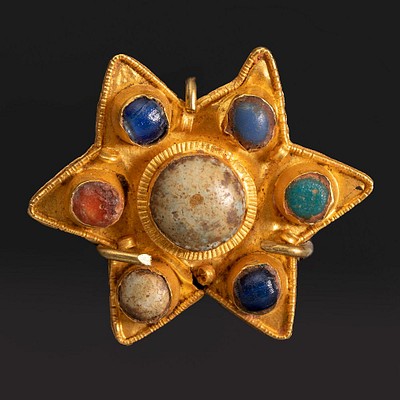ALFREDO PALMERO DE GREGORIO (Ciudad Real, 1901 - Barcelona, 1991). "Portrait of Julio Romero de Torres". 1928. Oil on canvas.
Lot 117
About Seller
Setdart Auction House
Carrer Aragó 346
Barcelona
Spain
Setdart Subastas was born in 2004 and is currently the first online art auction in Spain with solidity, prestige and reliability guaranteed by our more than 60,000 users. Setdart has a young, dynamic and enterprising team ready to successfully manage the purchase and sale of art works through custom...Read more
Estimate:
EUR€900 - EUR€1,000
$967.74 - $1,075.27
Absentee vs Live bid
Two ways to bid:
- Leave a max absentee bid and the platform will bid on your behalf up to your maximum bid during the live auction.
- Bid live during the auction and your bids will be submitted real-time to the auctioneer.
Bid Increments
| Price | Bid Increment |
|---|---|
| EUR€0 | EUR€10 |
| EUR€200 | EUR€25 |
| EUR€500 | EUR€50 |
| EUR€1,000 | EUR€100 |
| EUR€3,000 | EUR€200 |
| EUR€5,000 | EUR€500 |
| EUR€10,000 | EUR€1,000 |
| EUR€20,000 | EUR€2,000 |
| EUR€50,000 | EUR€5,000 |
About Auction
By Setdart Auction House
Dec 21, 2021
Set Reminder
2021-12-21 07:30:00
2021-12-21 07:30:00
America/New_York
Bidsquare
Bidsquare : Córdoba: 2,000 Years of Art
https://www.bidsquare.com/auctions/setdart-auction-house/c-rdoba-2-000-years-of-art-8049
Setdart Auction House sofia@setdart.com
Setdart Auction House sofia@setdart.com
- Lot Description
ALFREDO PALMERO DE GREGORIO (Ciudad Real, 1901 - Barcelona, 1991). "Portrait of Julio Romero de Torres". 1928. Oil on canvas. Presents craquelure on the pictorial layer. Signed, dated and located. Measurements: 62 x 49 cm; 75 x 63 cm (frame). Work in which is represented a portrait of Julio Romero de Torres (Cordoba, 1874 - 1930) who was the greatest exponent of symbolism in Spain. The genius of his work lay in its transgression of the limits between the sublime and the decadent, taking a risk that exerted a strong attraction among the intellectuals of the end of the century. His success was to link symbolism with the casticismo inherent in the Spanish culture of the 19th century, related to the regionalist theme and driven by romanticism. Of Neapolitan descent, Alfredo Palmero showed a clear interest in painting from childhood. In his adolescence, and in search of new horizons, in 1913 he moved to Madrid to enter the Academia de Bellas Artes de San Fernando, at the age of fourteen. There he had as teachers Sorolla, Romero de Torres and Valle Inclán, the latter as professor of aesthetics. During these years he also frequently visited the studio of the photographer and painter Vicente Rubio Sánchez. Palmero became fully integrated into the bohemian atmosphere of the capital, and was a regular at the gatherings of well-known cafés such as "El Parnasillo" and "La Fontana de Oro", where the liberal and intellectual atmosphere stood out. There he made contact with Unamuno, Juan Ramón Jiménez, García Lorca and Manuel de Falla, among others. During these years, it was precisely the atmosphere of the cafés of the time, full of splendor and culture, that he would capture in his canvases. In 1920, after making his individual debut at the Casino of Ciudad Real, he left Madrid and moved to Paris, attracted by the pictorial novelties of the French capital. In this city he became interested in new trends such as Dadaism, and especially Apollinaire and other prominent figures of the time. At this stage he began to produce his moving and personal works, focused through a look of romantic heritage. His painting is filled with luminosity, rich chromatism, formal exuberance, sharpness in perspective and, above all, pictorial fantasy. Thus his paintings of the Folies Bergère, Pigalle, Montmartre, Montparnasse, etc. were born. He then made a series of trips to Germany, Italy and Belgium, where he portrayed, as he had already done in Madrid and Paris, the daily life of the cities. On his return to Spain he taught art in Ciudad Real, Burgos, Toledo and Barcelona, the latter city where he settled definitively in 1940. Barcelona became his platform to Europe and America, where he founded the Palmero Institute of Art. In 1964 he created the Palmero Museum in his hometown, Almodóvar del Campo, in a mansion in La Mancha, where he used to spend his summers. In 1972 he was named Favorite Son of Almodóvar, and in 1983 he joined the Institute of La Mancha Studies. During his life, he exhibited his work both in Spain and abroad, in cities such as Osaka, Paris, Brussels, Florida, Bogota and Caracas. Maestro Palmero is currently represented in the museum that bears his name in Almodóvar and in the museum of Don Quixote in Ciudad Real, as well as in private collections in Spain and abroad.
- Shipping Info
-
In-house shipping available. Please inquire at admin@setdart.com.
-
- Buyer's Premium



 EUR
EUR CAD
CAD AUD
AUD GBP
GBP MXN
MXN HKD
HKD CNY
CNY MYR
MYR SEK
SEK SGD
SGD CHF
CHF THB
THB















